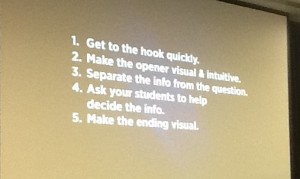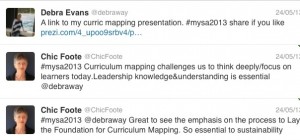Being on the management committee of Adolescent Success (formerly MYSA) and a member of the organising committee for our International conferences affords me valuable experience, access, insight and connections that contribute to my continuing learning journey. Having that insider ‘info’ assists members of my staff also, to engage in opportunities for furthering their professional growth and development. And so, with a small team of educators from my college and the management committee of Adolescent Success, we travelled to Singapore to The Australian International School (our conference site) to engage in global learning around middle years learners – our Inaugural Asia Pacific Conference.
The Keynote’s key notes
With its theme “Global students, Real solutions“, our conference brought together three dynamic keynote speakers – Veronica Boix Mansilla (Project Zero- Harvard Graduate school), Dan Haesler (Educator, writer, consultant and speaker- Australia) and Association of Middle Level Education (AMLE) Director of Middle Level Services, Dru Tomlin (USA) who all expertly challenged and engaged the audience of middle years educators from Australia, New Zealand, UK, Singapore, Thailand, and Vietnam. The themes sparked robust conversation both inside the sessions and via social media, as marked by the ‘trending’ twitter feed #apcas14 by day 2. These keynote sessions most definitely reactivated important discussions about the type of learning that we should be focusing on in this century, providing theoretical and research based evidence, as well as practical processes and real examples of approaches and strategies that we can employ to do this – on local, national and global scales.
Veronica’s sessions engaged us to think critically about the world today and the meaning of education within this context. She tells us that “It is essential for educators to understand that the world for which we are preparing students today is fundamentally different from the one we experienced growing up. Today’s societies are marked by new global economic, cultural, technological and environmental trends that are part of a rapid and uneven wave of globalisation.” She further challenged us to ask of ourselves as thoughtful educators:
• What matters most to teach in an increasingly interdependent world?
• What skills and dispositions should students develop to address the global issues defining their times?
During her first session we examined the nature of global competence as a “promising aim of education in the 21st century”. We were urged to deliberately incorporate global competencies within our learning frameworks, to ensure that our students experience and acknowledge global perspective and relevant disposition (ways of being). Veronica provided valid evidence to support that this can no longer be achieved (successfully) through single discipline teaching and learning. Interdisciplinary and connected learning that uses locally oriented thinking, digitally connected thinking and embracing divergent and differences in thinking is critical in today’s world.
Veronica incorporated global thinking routines and workshopped with us encouraging us to consider perspective and disposition ourselves-modelling the processes and leading us to the emergence of deep conversation and consequently deeper learning. Using the See, think, Wonder process and then a 3 Why’s analysis enabled us to drill down and think deeply. These Processes should be used within our classrooms on a daily basis to encourage valid and deep conversation and examination of real issues and problems. These are the types of processes that should form the basis of our curriculum as are articulated through the Australian Curriculum General Capabilities -Critical and creative thinking and ethical understanding, intercultural understanding, personal and social capability, along with ICTs, literacy and numeracy. These General Capabilities must be the drivers for curriculum development, not the content descriptors (that so many teachers focus on).
Her insights provide me further reason to examine my role as an educator of middle years learners, and as a leader within my school setting to ensure that we do create conditions for our learners to become globally competent. To successfully enable this to occur, we must consider some key questions:
What is our mission? What do we value for our learners? How do we empower our teachers and learners to become globally competent?
Through the spaces we create, the schedules we set in place, the resources we provide and the people we employ and of course the curriculum and programs we implement; all of these are considerations for our learning community. Along with these factors, the big and small connections we make to the real world in our programs become critical components and drivers for learning (for all) in these times in our school settings.
Our next keynote, Dan Haesler then provided us with data and statistics on student engagement and the impact of this on success and consequently, learning. He highlighted that “engagement is one of the most over-used words in education, yet all too often we misunderstand the core ideals of engagement and in doing so, we miss the opportunities for authentic learning to take place in our schools and communities.”
He sees intrinsic motivation as the “secret sauce of genuine engagement”, and as such, the real question should be “how can we create environments that encourage and nurture intrinsic motivation, whilst realising – by its very nature – we can’t make students be intrinsically motivated.
We can’t make students engage – even if we do give them all iPads.” Dan reinforced the notion that it is in the pedagogical approaches that the teacher employs, the relationships developed with the students and the connections made between the learners and within the community, that motivation (and maybe engagement) can follow.
In his keynote, Dan explored a number of key perceptions, ideas and questions relating to engagement. He challenged us to “consider the world our kids inhabit, and how that impacts what they expect at school”, which raised again that central issue of global competencies. As well, he asked us to think about whether we really know what engagement looks like, and to focus our energy on what is needed to enhance engagement in our students – how we can foster a sense of autonomy, mastery and purpose in our students; these being essential for lifelong learning. That key question to consider- Would your students really come to your class if they had a choice?
For me, Dan has reinforced that we need to be learner centred and learning focused, developing relationships both with our students and within our communities. We should be having conversations around what THEY need, not what WE need. We must “Empower our learners to change someone’s world.” Not necessarily THE world!
The last, but definitely not least of the keynotes focused us again, through his quirky and energetic approach of the modelling of practical and engaging strategies, on Pastoral Care and Advocacy. Again, the focus brought back to relationships, building safe and engaging classroom environments and school communities that engender a culture of belonging, trust, and inclusion.
Dru Tomlin exuded passion, enthusiasm and a love of learning and being. As an energetic advocate of the Association for Middle Level Education’s foundational text, ‘This We Believe‘, he “models that (advisory) pastoral care and advocacy are critical ingredients in the recipe of an effective middle school”, and in fact within any school setting for that matter. He reinforced that “these key ingredients; however, must be relevant and purposeful within the school context, which at times can be challenging!” Dru expertly and enthusiastically provided impetus for us to examine more fully the what, when, where and how of making pastoral care and advocacy work to improve the lives of young adolescents. All members of the community MUST be privy to this culture- not just the teachers. As leaders, we must ensure that the ‘Pastoral’ and the ‘rest’ are interconnected.
And so, we threw around (literally) our thoughts on middle years learners, and thoughts that are relevant to our own contexts of learners. “We were asked, “In one word to describe a middle years learner if they were an animal”. “What if they were food?” The snowball activity is one that I will definitely incorporate in the next staff meeting, or as a class starter – a highly effective strategy from a kinaesthetic perspective and a thinking one too. Dru, not only continued to make us think deeply about what and how we do what we do within our school settings, but reminded us of the types of activities and processes that are effective middle years strategies. Engaging and fun- I would most definitely enjoy being in his classroom- I would come back for more, every day. He shared (and demonstrated) many valuable ideas to ignite practical approaches within the classroom setting.
He challenged us to remember that Pastoral Care and Advocacy should be at the centre of the learning and that each and very staff member must be doing that same thing (the engendered culture); this is Critical.
For me then, the keynotes most definitely had KEY notes. They have energised my purpose – that focus on middle years learners; that focus on learning for today. Engendering a culture, one that is valued by all. We do want our students to be excited, engaged and competent – locally and globally.
The Keynotes set the tone for all of the sessions at the Adolescent Success Inaugural Asia Pacific Conference. The shared enthusiasm was palpable and the conversation critical if we are truly dedicated to engaging our learners and providing the necessary catalysts to enable global citizens for this world, in this day. It is our role as educators to assist these young people; to ensure they can function empathetically and confidently; to be globally competent citizens. Much food for thought and a definite call to action for all educators today.
PS – For me, middle years learners are possums– they may sneak around at night, at times be a little coy, but they are cute and cuddly and should be protected, yet let to run free. What is yours?



